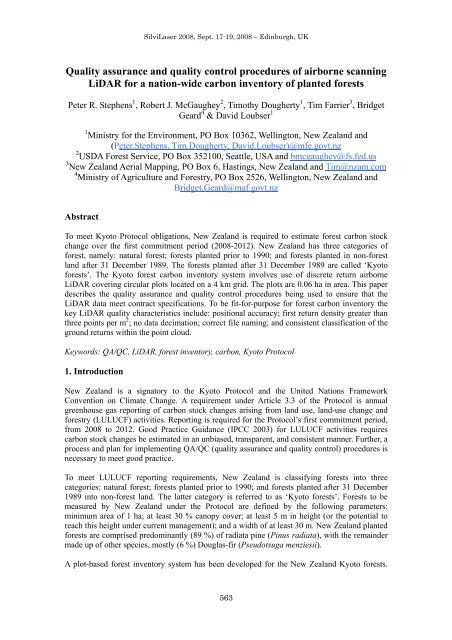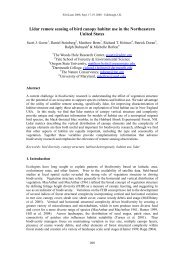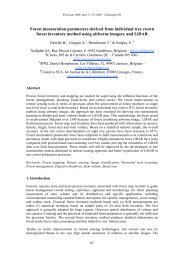Quality assurance and quality control procedures of airborne ...
Quality assurance and quality control procedures of airborne ...
Quality assurance and quality control procedures of airborne ...
Create successful ePaper yourself
Turn your PDF publications into a flip-book with our unique Google optimized e-Paper software.
SilviLaser 2008, Sept. 17-19, 2008 – Edinburgh, UK<strong>Quality</strong> <strong>assurance</strong> <strong>and</strong> <strong>quality</strong> <strong>control</strong> <strong>procedures</strong> <strong>of</strong> <strong>airborne</strong> scanningLiDAR for a nation-wide carbon inventory <strong>of</strong> planted forestsPeter R. Stephens 1 , Robert J. McGaughey 2 , Timothy Dougherty 1 , Tim Farrier 3 , BridgetGeard 4 & David Loubser 11 Ministry for the Environment, PO Box 10362, Wellington, New Zeal<strong>and</strong> <strong>and</strong>(Peter.Stephens, Tim.Dougherty, David.Loubser)@mfe.govt.nz2 USDA Forest Service, PO Box 352100, Seattle, USA <strong>and</strong> bmcgaughey@fs.fed.us3 New Zeal<strong>and</strong> Aerial Mapping, PO Box 6, Hastings, New Zeal<strong>and</strong> <strong>and</strong> Tim@nzam.com4 Ministry <strong>of</strong> Agriculture <strong>and</strong> Forestry, PO Box 2526, Wellington, New Zeal<strong>and</strong> <strong>and</strong>Bridget.Geard@maf.govt.nzAbstractTo meet Kyoto Protocol obligations, New Zeal<strong>and</strong> is required to estimate forest carbon stockchange over the first commitment period (2008-2012). New Zeal<strong>and</strong> has three categories <strong>of</strong>forest, namely: natural forest; forests planted prior to 1990; <strong>and</strong> forests planted in non-forestl<strong>and</strong> after 31 December 1989. The forests planted after 31 December 1989 are called ‘Kyot<strong>of</strong>orests’. The Kyoto forest carbon inventory system involves use <strong>of</strong> discrete return <strong>airborne</strong>LiDAR covering circular plots located on a 4 km grid. The plots are 0.06 ha in area. This paperdescribes the <strong>quality</strong> <strong>assurance</strong> <strong>and</strong> <strong>quality</strong> <strong>control</strong> <strong>procedures</strong> being used to ensure that theLiDAR data meet contract specifications. To be fit-for-purpose for forest carbon inventory thekey LiDAR <strong>quality</strong> characteristics include: positional accuracy; first return density greater thanthree points per m 2 ; no data decimation; correct file naming; <strong>and</strong> consistent classification <strong>of</strong> theground returns within the point cloud.Keywords: QA/QC, LiDAR, forest inventory, carbon, Kyoto Protocol1. IntroductionNew Zeal<strong>and</strong> is a signatory to the Kyoto Protocol <strong>and</strong> the United Nations FrameworkConvention on Climate Change. A requirement under Article 3.3 <strong>of</strong> the Protocol is annualgreenhouse gas reporting <strong>of</strong> carbon stock changes arising from l<strong>and</strong> use, l<strong>and</strong>-use change <strong>and</strong>forestry (LULUCF) activities. Reporting is required for the Protocol’s first commitment period,from 2008 to 2012. Good Practice Guidance (IPCC 2003) for LULUCF activities requirescarbon stock changes be estimated in an unbiased, transparent, <strong>and</strong> consistent manner. Further, aprocess <strong>and</strong> plan for implementing QA/QC (<strong>quality</strong> <strong>assurance</strong> <strong>and</strong> <strong>quality</strong> <strong>control</strong>) <strong>procedures</strong> isnecessary to meet good practice.To meet LULUCF reporting requirements, New Zeal<strong>and</strong> is classifying forests into threecategories: natural forest; forests planted prior to 1990; <strong>and</strong> forests planted after 31 December1989 into non-forest l<strong>and</strong>. The latter category is referred to as ‘Kyoto forests’. Forests to bemeasured by New Zeal<strong>and</strong> under the Protocol are defined by the following parameters:minimum area <strong>of</strong> 1 ha; at least 30 % canopy cover; at least 5 m in height (or the potential toreach this height under current management); <strong>and</strong> a width <strong>of</strong> at least 30 m. New Zeal<strong>and</strong> plantedforests are comprised predominantly (89 %) <strong>of</strong> radiata pine (Pinus radiata), with the remaindermade up <strong>of</strong> other species, mostly (6 %) Douglas-fir (Pseudotsuga menziesii).A plot-based forest inventory system has been developed for the New Zeal<strong>and</strong> Kyoto forests.563
SilviLaser 2008, Sept. 17-19, 2008 – Edinburgh, UK2.3 LiDAR system <strong>and</strong> data processing overviewThe LiDAR survey was flown using a Cessna 207 aircraft. An Optech ALTM 3100EA LiDARsensor was mounted in the aircraft, along with an integrated Rollei AIC digital camera. Table 1summarises the LiDAR <strong>and</strong> flight parameters used to achieve a target point spacing <strong>of</strong> 0.5m.The digital camera was used in t<strong>and</strong>em with the LiDAR sensor. The resulting colourphotography had a ground resolution <strong>of</strong> 0.2 m <strong>and</strong> a forward overlap <strong>of</strong> 30 per cent. The systemalso utilised an Applanix 510 Position <strong>and</strong> Orientation System (POS) that uses the GPS <strong>and</strong>IMU sensors, <strong>and</strong> a GPS-based computer <strong>control</strong>led navigation system.System WavelengthTable1: Summary <strong>of</strong> narrow beam, discrete return, LiDAR data <strong>and</strong> flight detailsScananglePulsefrequencyScanfrequencySwathwidthFootprintdiameter*GroundspeedFlyingheight**OptechALTM 1064 nm ± 6 deg 70 kHz 53Hz 170 m 0.27 m 105 knots 1200 m3100EA* beam divergence based on full width <strong>and</strong> half height <strong>of</strong> beam; ** height above ground levelThe POS data were processed using Applanix POSPac s<strong>of</strong>tware <strong>and</strong> the LiDAR 3D point cloudgeneration was completed using DASHMap s<strong>of</strong>tware. LiDAR point cloud classification,product generation <strong>and</strong> orthophoto production was accomplished using the TerraSolid suite <strong>of</strong>LiDAR processing s<strong>of</strong>tware.2.4 QA/QC activities undertaken by contractorData acquisition <strong>and</strong> pre-processing began with the application <strong>of</strong> rigorous sensor calibration<strong>procedures</strong> to ensure relative accuracy <strong>of</strong> the point cloud with absolute positional accuracybeing maintained through adopting “<strong>procedures</strong> that have been demonstrated to produce datawith particular horizontal <strong>and</strong> vertical accuracy values” (FGDC 1998).Sensor calibration was a key QC activity. LiDAR boresight alignment <strong>and</strong> scanner scaleparameters were determined from LiDAR data collected over a calibration range located closeto the aircraft operating base. The calibration range was flown at regular intervals during theaerial acquisition phase <strong>of</strong> the project. These data were used to confirm whether or not theboresight alignment <strong>and</strong> scanner scale parameters varied over time. The LiDAR point intensitydata were also monitored by reviewing histograms <strong>of</strong> point intensity values within a subset <strong>of</strong>the calibration range, <strong>and</strong> checking for changes in their shape <strong>and</strong> statistical characteristics.The absence <strong>of</strong> a suitable network <strong>of</strong> continuously operating GPS reference network basestations in New Zeal<strong>and</strong>, <strong>and</strong> the geographic extent <strong>of</strong> the project, made it necessary to useadvanced Precise Point Positioning (PPP) algorithms during the post-processing <strong>of</strong> the POSGPS data. To monitor the performance <strong>of</strong> the PPP output, base stations were operated from timeto time throughout the project. When collected, the base station data were used to generatedifferential GPS (dGPS) based sensor trajectories <strong>and</strong> these were then used in the QA <strong>of</strong> the PPPbased sensor trajectories.Following the generation <strong>of</strong> the LiDAR point cloud with DASHMap s<strong>of</strong>tware, QA <strong>of</strong> thecollected data for swath width/site coverage <strong>and</strong> point cloud density was undertaken afterloading the LiDAR data into TerraScan LiDAR processing s<strong>of</strong>tware. The target outgoing pulsepoint density <strong>of</strong> four points per square metre (with a minimum <strong>of</strong> three points) in a single flightline required the aircraft pilot <strong>and</strong> sensor operator to be vigilant in maintaining correct groundspeed, altitude <strong>and</strong> track over steeply undulating terrain.566
SilviLaser 2008, Sept. 17-19, 2008 – Edinburgh, UKRigorous folder <strong>and</strong> file naming conventions built around unique site identifies <strong>and</strong> acquisitiondates was used to track the data from its raw state after <strong>of</strong>f-load from storage devices on theaircraft through to delivered products. The products were delivered in blocks created on the date<strong>of</strong> acquisition <strong>and</strong> were accompanied by ISO 19115 compliant metadata XML files containingboth m<strong>and</strong>atory <strong>and</strong> optional field entries.2.5 QA activities undertaken by clientQA activities undertaken by the client involved use <strong>of</strong> the FUSION LiDAR visualisation <strong>and</strong>analysis s<strong>of</strong>tware (McGaughey et al. 2004) <strong>and</strong> ERDAS IMAGINE s<strong>of</strong>tware. Batch processing<strong>of</strong> LiDAR data with the FUSION s<strong>of</strong>tware was undertaken to assess data for all flight lines <strong>and</strong>all classified sites. The batch processing produced HTML QA reports, which contained numeric<strong>and</strong> image outputs.For each LiDAR flight line <strong>and</strong> each site datasets, FUSION was used to determine first return(pulse) density, return density, <strong>and</strong> to produce an intensity image <strong>of</strong> the area covered by thedatasets. A ground surface model was also created with FUSION from the flight line <strong>and</strong> siteLiDAR datasets. The ground surface model is generated by filtering the LiDAR point cloud toidentify ground returns. The filtering method used is an adaptation <strong>of</strong> the iterative methoddeveloped by Kraus <strong>and</strong> Pfeifer (1998). The FUSION filtering method is described in Andersenet al. 2006.The FUSION LiDAR data viewer was used to visually assess the site point cloud LiDAR dataclassified by the contractor as ground surface. This was accomplished by comparing theclassified data with the independently created (using FUSION) ground surface model, <strong>and</strong> byrotating the point cloud to establish if there were any points at an elevation less than thoseclassified as ground surface. These assessments were undertaken for five per cent <strong>of</strong> the plotsites.The ground surface model for the flight lines were exported from FUSION as a Surfer ASCIIgrid file. In ERDAS the elevations along the centreline <strong>of</strong> the flight line ground surface modelswere adjusted by applying an elevation <strong>of</strong>fset obtained from reference to a 10 cm contour Geoidseparation model. Then the adjusted elevations were compared with elevations for the samecentreline sampling area in a national 15 m digital elevation model. This model has a verticaluncertainty <strong>of</strong> ±10 m. Flight line elevation comparisons were to provide a ‘reasonableness’check <strong>of</strong> LiDAR-derived elevations against a nation-wide digital elevation model.File names <strong>and</strong> geographic position <strong>of</strong> all ploy data were checked using ARCInfo s<strong>of</strong>tware. Thiswas accomplished by comparing post-processing plot location shapefiles with shapefiles (withfile names <strong>and</strong> spatial location) <strong>of</strong> plots to be surveyed.3. Results3.1 Sensor calibrationThe LiDAR sensor calibration range was flown four times through the course <strong>of</strong> the acquisition.Height difference statistics between 600 ground surveyed points <strong>of</strong> the calibration range <strong>and</strong> theLiDAR point cloud were calculated following the checking <strong>of</strong> the boresight alignment <strong>and</strong>scanner scale parameters. Table 2 summaries these statistics <strong>and</strong> the range <strong>of</strong> return pulseintensity values for two <strong>of</strong> the calibration sorties. These are typical <strong>of</strong> the values obtained foreach <strong>of</strong> the calibration flights.567
SilviLaser 2008, Sept. 17-19, 2008 – Edinburgh, UKFigure 2.3.4 Assessment <strong>of</strong> LiDAR-derived ground surface modelsVisual comparison <strong>of</strong> the contractor ground-classified data for the sites with the client createdground surface model showed no discernable difference between the two. Elevation pr<strong>of</strong>iledifferences for a typical flight line in steeply undulating hill country are shown in Figure 3.Figure 2: Left image shows an extract <strong>of</strong> a site orthophotograph. A circular plot site is located within thewhite rectangle. The two white points mark the ends <strong>of</strong> a transect through the site. The right image showsthe client-produced ground surface model <strong>and</strong> a 5 m wide point cloud coloured using the height aboveground along the transect. The first return density for the site is 3.46 points per m 2 .Figure 3: The top two lines show heights from Geoid-corrected LiDAR data <strong>and</strong> a corresponding pr<strong>of</strong>ilefrom a national digital elevation model. The lower line shows the elevation differences between the twodata sources. The large elevation difference is 25 m, 2.5 km into the flight line.4. DiscussionOver the past decade many studies have demonstrated that <strong>airborne</strong> LiDAR can provide dataappropriate for resource management, including forest inventory. Over this time LiDARtechnology has been widely used for high-resolution terrain analysis <strong>and</strong> mapping. NationalQA/QC st<strong>and</strong>ards <strong>and</strong> guidelines for LiDAR data collection are well developed for terrainanalysis <strong>and</strong> mapping (ILMB 2006; Stoker et al. 2007). However, st<strong>and</strong>ards <strong>and</strong> guidelines for569
SilviLaser 2008, Sept. 17-19, 2008 – Edinburgh, UKforestry applications are not as well advanced. McGaughey et al. (2006) described therequirements for LiDAR data for forestry measurements <strong>and</strong> highlighted the deliverables,specific to forestry applications that should be included in data acquisition contracts.This operational LiDAR forest inventory project involved 758 small forest sites, on l<strong>and</strong>ranging from sea level <strong>and</strong> 940 m elevation, <strong>and</strong> located over a large geographic area. TheQA/QC activities undertaken by the contractor were designed specifically for the project, with<strong>quality</strong> being maintained through the application <strong>of</strong> flying skill, rigorous processes <strong>and</strong>advanced technology. Further, the QA processes undertaken by the client <strong>and</strong> conducted within10 days <strong>of</strong> data delivery, were designed to provide rapid feedback to the contractor, <strong>and</strong> toensure that the LiDAR data were appropriate for the intended purpose, namely forest carboninventory. The QA/QC processes documented here provide a basis for establishing forestryst<strong>and</strong>ards <strong>and</strong> guidelines for <strong>airborne</strong> LiDAR data acquisition <strong>and</strong> processing.ReferencesAndersen, H-E., Reutebuch, S.E., <strong>and</strong> McGaughey, R.J., 2006. A rigorous assessment <strong>of</strong> tree heightmeasurements obtained using <strong>airborne</strong> lidar <strong>and</strong> conventional methods. Canadian Journal <strong>of</strong>Remote Sensing, 32 (5), 355-366.Csanyi, N., Edwards, K., Grejner-Brzezinska, D., <strong>and</strong> Toth, C., 2007. Geodetic grade <strong>airborne</strong>LiDAR mapping. In Proceedings <strong>of</strong> the Institute <strong>of</strong> Navigation, National Technical Meeting,January 22-24, 2007, San Diego, USA, 1, 495-503.Drake, J.B., Dubayah, R.O., Clark, D.B., Knox, R.G., Blair, J.B., <strong>and</strong> H<strong>of</strong>fman, M.A., 2002.Estimation <strong>of</strong> tropical forest structural characteristics using large-footprint LiDAR.Remote Sensing <strong>of</strong> Environment, 79, 305-319.Federal Geographic Data Committee, 1998. Geospatial Positioning Accuracy St<strong>and</strong>ards Part 3:National St<strong>and</strong>ard for Spatial Data Accuracy. FGDC-STD-007.3-1998.Kraus, K., <strong>and</strong> Pfeifer, N., 1998. Determination <strong>of</strong> terrain models in wooded areas with <strong>airborne</strong>laser scanner data. ISPRS Journal <strong>of</strong> Photogrammetery <strong>and</strong> Remote Sensing, 53, 193-203.ILMB, 2006. LiDAR specifications. Ministry <strong>of</strong> Agriculture <strong>and</strong> L<strong>and</strong>s, Integrated L<strong>and</strong>Management Bureau (ILMB), Base Mapping <strong>and</strong> Geomatic Services Branch, Victoria, BritishColumbia, Canada, Version 0.05, 35.McGaughey, R.J., Carson, W.W., Reutebuch, S.E., <strong>and</strong> Andersen, H.-E., 2004. Direct measurement<strong>of</strong> individual tree characteristics from LiDAR data. In: Proceedings <strong>of</strong> the 2004 Annual ASPRSConference, May 23-28 2004; Denver, Colorardo: Bethesada, MD. American Society <strong>of</strong>Photogrammetry <strong>and</strong> Remote Sensing. unpaginated CD-ROM.McGaughey, R.J., Andersen, H.-E., <strong>and</strong> Reutebuch, S.E., 2006. Considerations for planning,acquiring, <strong>and</strong> processing LiDAR data for forestry applications. In Proceedings <strong>of</strong> the 11 thBiennial USDA Forest Service Remote Sensing Applications Conference, April 24-28 2006,Salt Lake City, USA.Nelson, R., Valenti, M.A., Short, A., <strong>and</strong> Keller, C., 2003. A multiple resource inventory <strong>of</strong> Delawareusing <strong>airborne</strong> laser data. Bioscience, 53, 981-992.IPCC, 2003. Penman, J., Gytarsky, M., Hiraishi, T,, Krug, T., Kruger, D., Pipatti, R., Buendia, L.,Miwa, K., Ngara, T., Tanabe, K., <strong>and</strong> Wagner, F (Eds). Good Practice Guidance for L<strong>and</strong> Use,L<strong>and</strong>-Use Change <strong>and</strong> Forestry. IPCC National Greenhouse Gas Inventories Programme.Published for the IPCC by the Institute for Global Environmental Strategies: Tokyo, Japan.Patenaude, G., Hill, R.A., Milne, R., Gaveau, D.L.A., Briggs, B.B.J., <strong>and</strong> Dawson, T.P., 2004.Quantifying forest above ground carbon content using LiDAR remote sensing. RemoteSensing <strong>of</strong> Environment, 93, 368-380.Stephens, P.R., Watt, P. J., Loubser, D., Haywood, A., <strong>and</strong> Kimberley, M.O., 2007. Estimation <strong>of</strong>carbon stocks in New Zeal<strong>and</strong> planted forests using <strong>airborne</strong> scanning LiDAR.Proceedings ISPRS Workshop on Laser Scanning 2007 <strong>and</strong> SilviLaser 2007, September12-14, Finl<strong>and</strong>, 389-394.570
SilviLaser 2008, Sept. 17-19, 2008 – Edinburgh, UKStoker, J., Parrish, J., Gisclair, D., Harding, D., et al., 2007. Report <strong>of</strong> the First National LidarInitiative Meeting, hosted by the USGS L<strong>and</strong> Remote Sensing Program, GeographyDiscipline. Report Series OF 2007-1189, US Department <strong>of</strong> the Interior <strong>and</strong> USGeological Survey, 64.571





